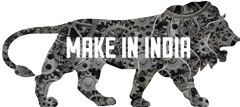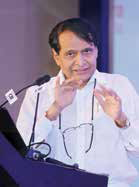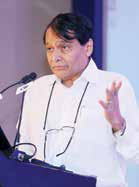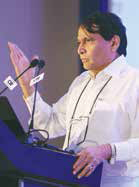“Make in India” will bring in a complete transformation of the economic activities in India. It is a vision of complete transformation of the country, an important intervention that we need to implement for development
It has been over three years since the Make-In-India initiative has been launched and several changes have been made. FDI norms for key manufacturing sectors have been relaxed, labour laws have started improving, and there is a much higher orientation to move up on the ‘Ease of Doing Business’ scale. However, manufacturing has continued to be a lukewarm sector over the last few years. Is ‘Making for India’ the missing link? Are we customising our efforts enough to serve the Indian market? Corporate Citizen, brings you excerpts from the inaugural address by, Suresh Prabhu, Minister of Commerce and Industry, Government of India, at the recently organised16th CII Manufacturing Summit 2017, in Mumbai, wherein he shared his views on the big opportunities for the manufacturing sector to serve Indian customers and what are the government’s efforts to make it happen

After completion of a decade of reforms, if we just continue to open economy and do not manufacture to the right scale in India, we face some serious challenges. Our Prime Minister, came out with this idea of “Make in India”— we must understand why Make in India? We all agree and no one can question it, doubt it or even stop it from India becoming a five-trillion- dollar economy, in the next few years’ time. And as it looks like, because of so many structural changes, it might be sooner than later. Even when India becomes a five-trillion-dollar economy, today’s GDP profile itself indicates that almost two-third of it is coming from services, which is more than 60 per cent. So, when you become that large an economy, the third largest in the world, it is not the end of the road. It will be another launching pad for the Indian economy to grow even higher. We all know that India added a trillion dollar, after hundreds of years of economic activity. Then we added another trillion, in a matter of few years. So, when we become five trillion, that again will be the starting point of higher trajectory of our growth. With these signs of growing economy, if only our services contribute significantly in the growth of economy— it will create lot of social issues, because we need to create jobs for people at all levels. If the economy has grown to that size then, each and every citizen of India must be able to share its benefits.

If we only create jobs of consultants, IT professionals, doctors, chartered accountants and others— yes, we need to create more of these jobs, but we must also must create jobs at the bottom level, the blue-collar jobs-we must have job creation and sharing of wealth at all levels. To do that obviously we must have manufacturers. Secondly, we have to sustain services. But, if there is no underlying strong manufacturing base, how will there be pull for service sector. If manufacture comes we need the raw materials and raw materials have to be transported from the place where it is produced to where it will be used for manufacturing processes. Then manufactured goods have to be moved to marketplace where they have to be sold, so it needs transportation. Manufacturing needs financial investment, so we need investors. Then for financial services, you need communication and in short, all kinds of services. So, it shows that services get a boost with manufacturing.
If we don’t manufacture, what are we going to do with our natural resources? Obviously, we can export and that’s what we have been doing. In a way, lot of countries which are industrialised, particularly in Asia, are partially owing to India, for producing large quantity of steel and exporting iron ore. It’s a different matter that it became one of the largest producer of steel, and could therefore manufacture lot of downstream activities. If you take industries that produce cars, we help them to industrialise—it is a very good idea that we help other countries to industrialise. When we have natural resources available and if we don’t convert them into manufactured products, what’s the value addition we are creating?

Make in India programme is not just make in India, but making of India. It would bring in a complete transformation of the economic activities in India. We should create the necessary value chains within the country. We should also integrate all the three important segments of GDP-agriculture, manufacturing and services. Thus, Make in India is a vision of complete transformation of the country, an important intervention that we need to implement for development. For example, India has now become the largest consumer of electronic goods and we will continue to do that as more and more electronic goods are becoming part of our daily life. If we are five-trillion- dollar economy, our spending power will increase all the more. So, people have to spend money—of course’ we can support other economies by spending more and buying more. Today, we have over one billion mobile users. If we continue to only import, what will be the impact on the external sector of India? So, we really need to focus on manufacturing and that’s why Make in India, is a complete and holistic programme for development of India.
Now having accepted that we must make in India, there are several issues we need to address. Firstly, what is that we should make in India? A better question to answer is what is that you cannot make in India? Firstly, there is so much of domestic demand-you can make anything and there is demand available for that. So, what we should do first, is change our mindset.

We have an argument—make or buy? What is the choice—you can easily buy rather than make. So, that is something we can think nationally, whether we should make or import— businesses can grow even by doing that. But, if we change our mindset and think I am going to make it and export also, not just import and sell, but make and export. So, this is our mindset issue that we should tackle and there I would appeal to everybody to think about it as a national duty that you are performing. Those who are actually making in India, are actually serving India.
The obvious question that arises is, making in India is not that easy. All the manufacturers face lot of problems, which is a fact. Therefore, we cannot expect the national duty to be performed by the citizens, unless the government itself takes the responsibility of addressing the concerns of those who are getting into performing the national duty. Make in India, cannot happen just by the effort of one segment of the society. It has to happen as a collective endeavour and government must play a significant part to actually make it happen. And that can be divided into broadly two parts—simplified as a software and hardware part.
Make in India cannot happen just by the effort of one segment of the society. It has to happen as a collective endeavour and government must play a significant part to actually make it happen. I would appeal to everybody to think about it as a national duty that you are performing
The software part—we should not create hurdles for manufacturing but facilitate it. Government must ensure that all the hurdles are removed— and all that can be done by the ‘Ease of doing business’ programme. In ease of doing business, we have already climbed quite a significant portion, but we need to go higher. The day after the result was announced that India has come to the position of 100, in the Ease of doing Business ranking, we called a meeting with all the stakeholders, including the World Bank team and all the ministries who are responsible, and said that now let us focus on taking India’s ranking to 50—it’s not going to happen tomorrow, but we have actually started working on that.

Secondly, in software part, there are structural issues. For example, with GST, we get one integrated market—a 1.3-billion-market is a significant market, it is almost 20 percent of global population. Of course, the number alone does not make a market, we have to also add the spending power to it. There is a very famous economic dichotomy that desire to buy doesn’t create demand, unless it is backed by purchasing power. So, as the incomes will rise, you can imagine the market side. How GST will help? There are some who pay taxes meticulously and some who don’t. How can one, who pays taxes, survive in marketplace? To invest in R&D you must have scale. If the bottom line is not strong enough, you won’t be able to invest. And if the bottom line is strong, you also need the top-line strong, therefore the volumes have to increase.
We want to encourage small industries, as they are the mainstay of India’s economy. They contribute significantly to exports. They are innovative and the biggest job creators, more than large industries. They try to create a niche for themselves and they survive. Those small- and medium-size industries would also like to grow bigger. Those small industries who pay taxes regularly, have to compete with other smallscale industries. How do you actually create this long-term marketplace where innovation will happen and sustain, and R&D will happen? One needs investment and for that one needs scale. So, scale which is necessary, will happen with GST.
One should admit and accept that this government is most responsive. I am a chartered accountant by training. We passed Income Tax Act in 1961, 56 years ago. All the successive governments, prime ministers and finance ministers, in every budget have said that they are amending so and so sections. The Income Tax Act, after having been there for so many years, has been amended so many times. GST has been introduced just six months ago, is such a complex law and so many states are involved— Income Tax law is a simple law comparatively. The initial problems of GST are obviously addressed and the government has been very responsive. There are initial issues and as we settle down in the next few weeks, we will see the huge benefits of GST.
About the hardware part—there again government has the responsibility to create infrastructure. We are targeting to invest at least 250 billion dollars into infra. For example, in the railways, in the last 70 years, we invested over 4 lakh crore. In first three years of the present government, we have committed to invested 3.75 lakh crore. We are doubling lines which are congested and electrifying lines—it’s a matter of time when you will clearly see the results. So, infrastructure is a hardware issue and we are trying to attend that, working in a manner that can actually work.
That again will need a little more deliberation. Broadly, we must think about new industries, which are not even born. We must identify new companies and where we should also focus-we have already started doing that.

We have traditional industries like textile, where we have natural advantage, because we have the raw materials, we have the manpower, we have experience of doing that business, but we must modernise. So, modernisation of existing businesses and thinking about new industries, is the way forward. These are few points we are working on and these will be part of our industrial policy as well.
We can never succeed only by manufacturing in India or only looking at the Indian market. Whether you like it or not, we are part of global economy. So, we have to benchmark our products against the best in the world and to do that, scale and investment are necessary. So, we must have exports and unless we create that at a global scale, we will not be able to compete.
We are working on creating a new organisation, for th first time, which will promote India’s exports globally. We will have offices at least in ten different geographies, to promote our exports, with market research backup, with promotional activities and completely different approach. And we will work for this with the private sector, so that together we will promote our exports and penetrate the global market. It is not possible for small Indian businessman to sit in India and do business globally, unless we create support system for small businesses and also the large businesses. The government is working on creating the brand equity for India globally. So, export in international market and linkage with domestic market, is very critical and we must do that. We have also started working on taking districts as units. We have gone to a few geographies, identifying specific geographies with specific products and markets.
India is a society and not a machine working mechanically. Surprises are part of our day-today life. We must understand the big picture— we are on the path of becoming the third largest economy in the world and that will be a beginning of an even onward journey
This is the time when the government and the industry priorities are aligned to each other. We have to work as partners and then only it will happen. So, the ecosystem that we talk about for manufacturing, must have government as a stakeholder, partner and facilitator. That’s the role we’d like to play. The kind of industry we have created despite the challenges in the past, shows that if government facilitates it, how much more we can do. The Prime Minister himself is very keen, who realises that entrepreneurship in India has to be promoted and hurdles of ease of doing business have to be removed. I am very sure that in the next few years’ time, we will achieve that.

We have been working on industrial corridors. I have already started talking with companies globally that they come and invest, so that one big industry coming in, will create lot of ecosystem for the SMEs to develop around it. Whatever good ideas come from such manufacturing summits organised by CII, we will be very happy to support. We will actually make it happen, in the shortest possible time and this is the national duty we must perform. Never get disheartened with short-term issues, they will always keep coming up. In a country as big as India, if everything is happening as planned, then there is something missing.
A very close friend of mine, a German minister, who said that he wants to come to India and spend some time with me. I asked why and he said that in Germany everything happens exactly as planned. So, I want to come to India, to know how you make it possible. So, this is our diversity we should be proud of. India is a society and not a machine working mechanically. Surprises are part of our day-to-day life. Don’t get disheartened with small issues here and there, we must understand the big picture. The big picture is, we are on the path of becoming the third largest economy in the world and that will be a beginning of an even onward journey and time itself will prove what it would be. That is India’s big future and we must contribute significantly to make it happen, by making manufacturing a good part of that process.
By Rajesh Rao